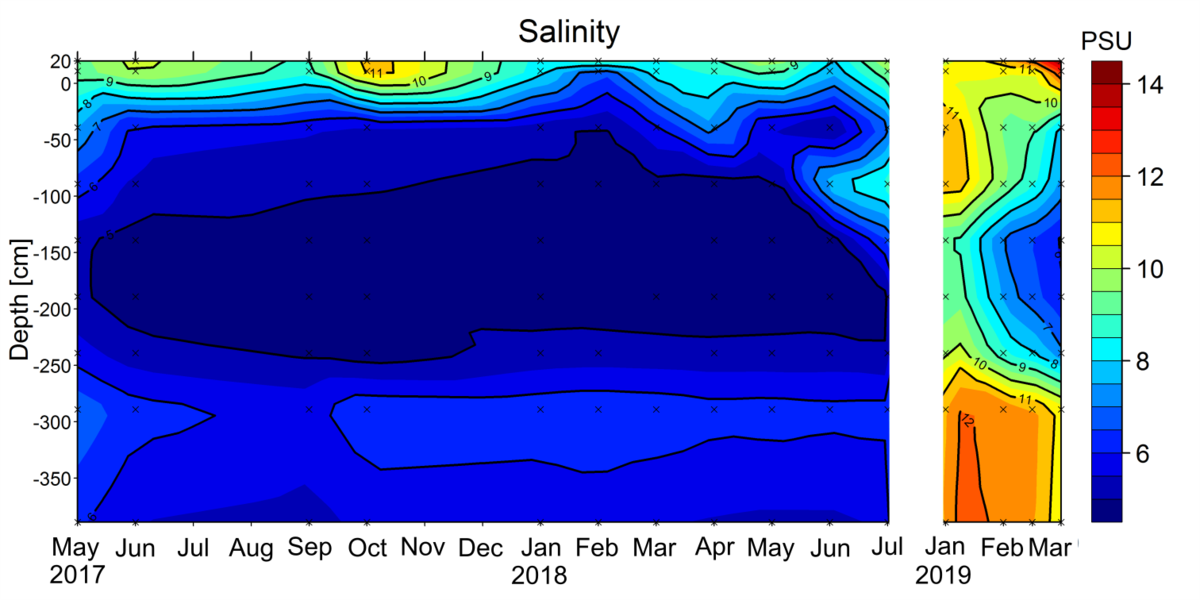G1: Impact of water and element exchange on biogeochemical processes at the Sea-Land interface of the southern Baltic Sea
supervised by Böttcher, Jurasinski, Voss

Focus
The influence of water (submarine groundwater discharge, SGD) and substances from the peatland to the Baltic Sea and vice versa, for element transformations in and fluxes from sediments and soils is in the target of this topic of Baltic TRANSCOAST. By means of multi-isotope, trace element and nutrient analysis in the water column, pore waters and slid phase from the sediments and the peatland on a transect between the bog and the Baltic Sea we will identify water and element sources, sinks and transformations and their regulating factors. This is compared to a previosly protected wetland that will undergo flooding by Baltic Sea water in the future. This is of particular interest for understanding the development of the biogeochemistry of coastal ecosystems in times of rising sea-level.
State of the Art
In coastal environments, sandy sediments may act as an active bioreactor, caused by intense advective water transport and further promoted by SGD. The interactions between aqueous solutions and reactive solid phases may lead to dynamic fixation and transformations of nutrients, carbon species, redox sensitive elements and a partial export of the products to the coastal waters. Furthermore, processes taking place in the groundwater and the interactions with brackish solutions upon SGD discharge are important factors controlling the overall element balance, thereby impacting the benthic-pelagic coupling of biogeochemical element cycles in the coastal Baltic Sea.
Work program
By the combination of stable isotope partitioning (H, C, O, S) , redox-sensitive trace metals in pore waters and solid phases of coastal sediments and peatland soils we will adress the impact of surfacial and subterrestrial water flow on biogeochemical processes. Together with measurements of Ra this will lead to budget of SGD in front of the Hütelmoor. The application of flux chambers (seepage meters) and pore water lances will complement the sampling to allow for a flux determination of water and elements and analyses of biogeochemical processes. We will further focus on the investigation of fluxes as a consequence of flooding of the coastal peatland area of Drammendorf tob e rewettet in winter 2019/2010. The biogeochemical consequences thereby will be followed in stau nascendi, inclduing budgeting the fluxes and folwoing changes of inventories. Selected major biogeochmical processes, as microbial sulfate reduction with salinity changes will be followed in the field, in mesocosm and laboratory incubations. Results will be synthesized allowing to understand and predict the impact of peatland flooding and SGD on coastal and wetland biogeochemistry.
References
Koebsch F, Winkel M, Liebner S, Liu B, Westphal J, Schmiedinger I, Spitzy A, Gehre M, Jurasinski G, Köhler S, Unger V, Koch M, Sachs T, Böttcher ME (2019) Sulfate deprivation triggers high methane production in a disturbed and rewetted coastal peatland. Biogeosciences 16:1937–1953
Wen X, Unger V, Jurasinski G, Koebsch F, Horn F, Rehder G, Sachs T, Zak D, Lischeid G, Knorr K-H, Böttcher ME, Winkel M, Bodelier PLE, Liebner S (2018) Predominance of methanogens over methanotrophs in rewetted fens characterized by high methane emissions. Biogeosciences 15:6519-6536
Jurasinski G, Janssen M, Voss M, Böttcher ME, Brede M, Burchard H, Forster S, Gosch L, Gräwe U, Gründling-Pfaff S, Haider F, Ibenthal M, Karow N, Karsten U, Kreuzburg M, Lange X, Leinweber P, Massmann G, Ptak T, Rezanezhad F, Rehder G, Romoth K, Schade H, Schubert H, Schulz-Vogt HN, Sokolova I, Strehse R, Unger V, Westphal J, Lennartz B (2018) Understanding the Coastal Ecocline: Assessing Sea-Land Interactions at Non-Tidal, Low-Lying Coasts through Interdisciplinary Research. frontiers in Marine Science doi: 10.3389/fmars.2018.00342
